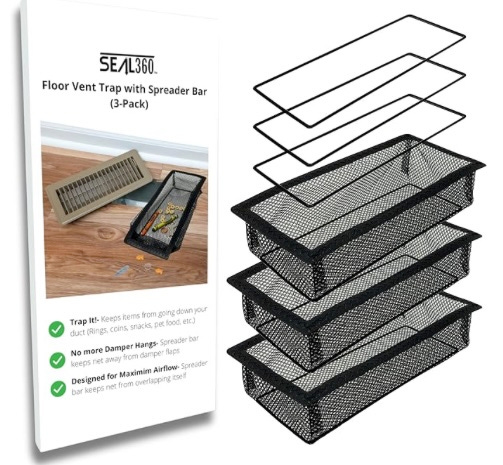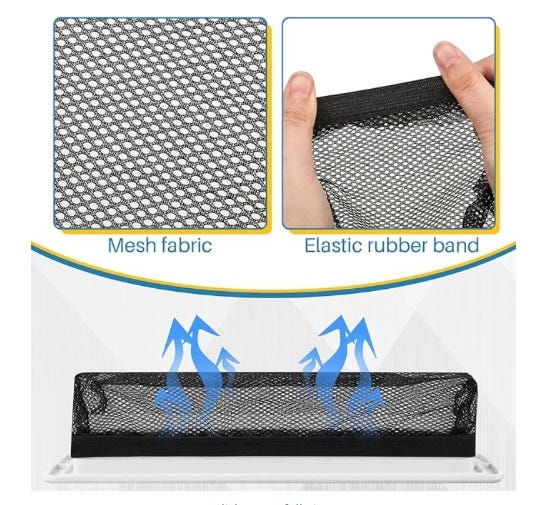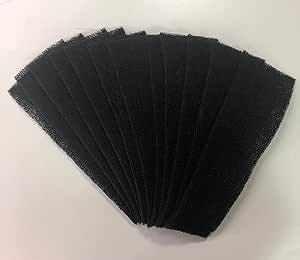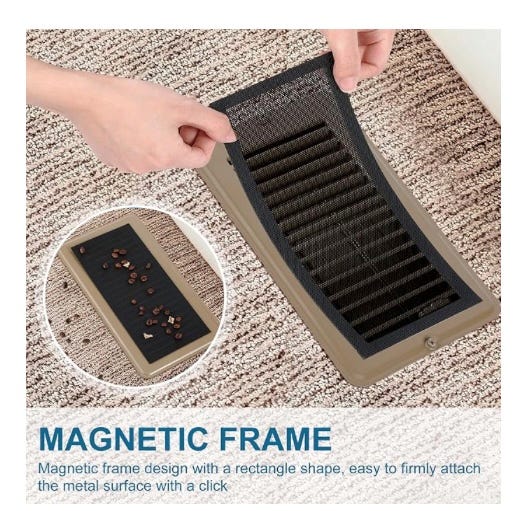Where would us RV folks be without our fuzzy and furry adventure sharing companions?
While their company is priceless, the shedding fur, tracked-in dirt, and occasional dropped kibble can create a challenge, especially with those ubiquitous floor vents found in many rigs, even the High end brand models. Debris falling into the ductwork isn't just unsightly; it can potentially impact airflow and cleanliness over time. Fortunately, there are several solutions available to keep your vents clear without compromising your RV's duct system.
This guide ranks the best options, from purpose-built products to basic maintenance, helping you choose the right approach for your RV and pets.
Subscribe 100% FREE
Recommendation: Mesh Vent Screens/Traps
Why they win: For the majority of RVers dealing with pet hair and the occasional dropped item, mesh vent screens or traps offer the most practical and balanced solution. They effectively act as a physical barrier, catching larger debris like clumps of pet hair, food particles, small toys, and even preventing curious insects from crawling up through the ducts. Well-designed mesh screens generally achieve this with minimal impact on the airflow essential for your furnace and AC systems, unlike denser filter materials. They address the most common annoyances without introducing significant new problems.
How they work: These products typically consist of a durable mesh netting attached to a frame or fitted with an elastic band. They are designed to be installed underneath your existing floor register (the decorative vent cover), sitting just inside the duct opening. When you lift the register, the trapped debris is contained within the mesh basket, ready to be easily discarded.
Product 1: Seal360
Description: This product is explicitly marketed for RV’s, to catch common culprits like toys, snacks, pet hair, small jewelry, and food before they vanish into the ductwork. A key feature is its patented "Spreader Bar" around the entire perimeter of the bottom designed to keep the mesh net fully open. This serves two purposes: maximizing the potential airflow through the vent and preventing the net from snagging on the register's damper mechanism, ensuring smooth operation. Installation involves simply placing it under the existing vent cover. It also acts as a barrier against bugs entering through the vents.
Pros: Specifically designed for common RV debris including pet hair, engineered for good airflow with the spreader bar feature , straightforward installation , effective bug barrier , generally durable construction.
Cons: Does not filter out fine dust or pet dander, cost per unit may be slightly higher than bulk filter material.
Price & Link: Approx. $23.97 for a 3-pack (common 4"x10" size). Other sizes are available. (Purchase Link Here)
Product 2:
Description: This option utilizes a mesh screen attached to an elastic band, designed to stretch around the underside of the floor register itself. The design aims to catch small items while allowing unrestricted airflow for ventilation. These often come in larger multi-packs, offering good value.
Pros: Economical, particularly in multi-packs , tool-free and very simple installation , designed to maintain airflow , effectively catches hair and larger debris , likely hand-washable for reuse.
Cons: Long-term durability of the elastic band could be a factor, some users reported that the register's damper fins could interfere with the mesh if the register isn't deep enough , will not capture fine dust particles.
Price & Link: Approx. $17.99 for a 12-pack (common 4"x12" size) (Purchase Link Hidden Here).
Addressing the Core Problem: Many RV owners' primary frustration isn't necessarily microscopic dust, but the tangible annoyance of losing small items down the vents or seeing visible pet hair accumulate. Living in compact RV spaces makes dropping things inevitable, and pets are constant sources of hair. Mesh screens directly tackle this immediate, visible problem by acting as a simple catch-basin. They provide a satisfying, low-risk solution to prevent these common occurrences without significantly altering the HVAC system's designed airflow, making them the top choice for general use.
Keep in Mind: It's important to remember these are screens or traps, not fine filters. While excellent for hair and dropped objects, they won't substantially reduce the circulation of fine dust, pollen, or pet dander through your HVAC system. If allergies are a major concern, other solutions might be needed in addition or instead.
SUBSCRIBE 100% FREE
Product 3:Cut-to-Fit Polyester Filters (For Finer Particle Capture)
Why they're runners-up: For RVers looking to capture finer particles like dust, pollen, and some pet dander, cut-to-fit filter media offers a step up in filtration compared to basic mesh screens. These products are often sold in multi-packs or large rolls that can be cut down, making them an economical option per vent. Their customizability allows them to fit various, sometimes non-standard, RV vent sizes.
How they work: This solution involves cutting a piece of filter material, typically made from polyester fibers, to the size of the vent opening. The cut piece is then placed underneath the floor register, usually just resting inside the duct opening or sometimes held loosely by the register itself. Some variations include multiple layers for progressive filtration, electrostatic properties to attract particles, or activated carbon layers for odor control.
Product Spotlight: Generic Cut-to-Fit Polyester Vent Filters (e.g., Duraflow, MGT, Filter Everything brands)
Description: These filters are generally made of 100% polyester fibers, sometimes featuring multiple density layers or electrostatic treatments to trap airborne particles like dust, dirt, pollen, pet hair, and dander. They are available pre-cut to standard register sizes or in larger rolls for custom cutting. Options with activated carbon aim to absorb household odors. Manufacturers often suggest a replacement interval of 60-120 days or around 90 days , but real-world use, especially with pets contributing hair and dander, will likely necessitate much more frequent changes.
Pros: More effective at filtering finer particles than mesh screens , generally low cost per filter, especially when purchased in rolls , allows for custom sizing , activated carbon options available for odor control.
Cons: Significant potential to restrict airflow, potentially straining the HVAC system so they may be best suited to a vent in just one room where the pet resides most often ; requires cutting if purchased in rolls; demands frequent monitoring and replacement, especially with pets ; actual filtration effectiveness varies based on material density (MERV rating, if provided).
Price & Link (Duraflow Carbon): Approx. $9.99 for a 12-pack (4"x12") (Purchase Link Here). Prices vary significantly across brands, quantities, materials, and features.
The Airflow Gamble: Adding any filter media introduces some resistance to airflow. While mesh screens are generally designed to minimize this, denser polyester filters inherently create more blockage because that's how they trap smaller particles. User reviews reflect this trade-off clearly: some report acceptable airflow, while others experience significant restriction, sometimes severe enough to raise concerns about system strain. Forum discussions echo these concerns, warning that restricted airflow can lead to furnace overheating or air conditioner coil freeze-ups. RV HVAC systems may be less robust than residential ones, making them more susceptible to issues caused by added airflow resistance. A gradual buildup of debris on the filter will only worsen the restriction over time. This variability suggests that the impact depends heavily on the specific filter's density, the RV's HVAC system design, and how diligently the filter is maintained. Using these filters requires accepting a degree of risk and committing to careful monitoring.
A Note on Carbon: Filters incorporating activated carbon are primarily beneficial for reducing odors. While helpful for pet smells, the carbon layer itself adds thickness and potentially further restricts airflow without necessarily improving fine particle filtration. Consider if odor control is a high priority worth the potential airflow trade-off.
Keep in Mind: CRITICAL AIRFLOW CHECK REQUIRED. If you opt for polyester filters, it is absolutely essential to monitor your HVAC system's performance after installation. Check for signs of strain like unusual furnace cycling, the AC unit struggling to cool or freezing up, or noticeably reduced airflow from vents further down the line. Filters must be checked and changed frequently – likely monthly or even more often in high-shedding households – to prevent excessive blockage.
SUBSCRIBE 100% FREE
Product 4: Steel RV Floor Vent
Why they're worth considering: A common complaint among RV owners is the flimsy nature of the standard-issue plastic floor vent registers. They are often located in high-traffic areas and are prone to cracking or breaking underfoot.Replacing these with sturdy metal (typically steel) registers addresses this durability issue head-on. While an upgraded register doesn't filter or block debris by itself, it provides a robust and reliable foundation upon which you can add a mesh screen or filter layer underneath.
How they work: These are direct replacements for the existing plastic registers. Installation is usually straightforward, involving the removal of a couple of screws holding the old vent, swapping it with the new metal one, and securing it with the same screws. They are available in standard RV floor vent sizes like 4"x10" and 4"x12" and often come in colors like brown or black to better match RV interiors. Some are available without dampers (non-adjustable) for maximum simplicity.
Description: Constructed from steel, these registers offer a significant durability upgrade compared to the easily damaged plastic originals found in many RVs. They are designed as direct replacements and are available in colors like brown to blend with common RV décor. Their solid construction prevents the cracking and breakage issues common with standard plastic vents, supporting foot traffic better.
Pros: Vastly more durable and resistant to cracking than stock plastic vents , often improves the aesthetic appearance , simple drop-in installation , creates a solid, long-lasting base for adding an underlying mesh screen or filter.
Cons: Does not inherently filter or block hair/dirt – requires pairing with a separate screen or filter layer, represents a higher initial cost compared to just adding a screen/filter to the existing plastic vent.
Price & Link Example: Approx. $8.10 each (current price may differ) (Purchase Link Here). Numerous other brands offer similar metal registers.
A Combined Approach for a Robust Solution: The issues with RV floor vents often stem from two distinct problems: the fragility of the cover itself and the open pathway for debris into the ductwork. Upgrading to a metal register effectively solves the durability problem. Adding a mesh screen trap (like our #1 recommendation) underneath this upgraded register addresses the debris problem with minimal airflow impact. Some users explicitly mention doing this, installing screen mesh under their replacement metal vents. This combination creates a synergistic solution: a durable, walkable vent cover paired with an effective, airflow-friendly debris catcher, addressing both weaknesses of the typical stock setup for a comprehensive, long-term fix.
Keep in Mind: This upgrade primarily enhances durability and aesthetics. To stop pet hair and dirt, you must still pair it with a mesh screen or filter placed underneath.
DIY 5:
This category covers methods that are either very basic or involve repurposing materials not specifically designed for HVAC use. While some can be part of a solution, others carry significant risks.
DIY Screens (Window Screen/Mesh):
Method, make your own : Some RVers attempt to create their own vent screens by cutting standard household window screen material to size and fitting it under the register, sometimes securing it with hot glue or simply letting the register hold it in place. I highly recommend strong small magnets instead if the vent is metal.
Pros: Extremely low material cost, can be cut to any size.
Cons: EXTREME CAUTION ADVISED. Standard window screen mesh is tightly woven and not designed for HVAC airflow. It can severely restrict airflow, potentially by 50% or even more. This level of restriction poses a serious risk of causing the furnace to overheat and shut down (or worse), the air conditioner coils to freeze, drastically reducing system efficiency, and potentially leading to expensive component damage. If not secured well, it might shift or get sucked into the duct. Any debris accumulation will rapidly worsen the already significant airflow blockage.
Verdict: Due to the high and often underestimated risk of critically impairing HVAC airflow, using standard window screen material as a vent filter is generally not recommended. The potential cost savings are heavily outweighed by the risk to your RV's essential systems. Purpose-built mesh traps (Recommendation #1) are engineered with airflow considerations in mind and are a much safer alternative.
Regular Vacuuming:
Method: This involves periodically (e.g., weekly or bi-weekly, depending on pets and usage) removing the floor vent register covers and using a vacuum cleaner with a hose attachment to clean out any accumulated hair, dirt, and debris from the vent opening and as far down into the accessible ductwork as possible. The register cover itself can also be washed.
Pros: Completely free, requires no additional parts or materials, directly removes accumulated debris, doesn't impede airflow when the system is running.
Cons: It's a reactive measure, not preventative – it doesn't stop hair, dirt, or objects from falling into the vents between cleanings. It also doesn't prevent debris already in the duct from being potentially blown out when the system activates (though some argue it mostly blows back out anyway ). Requires consistent manual effort and diligence.
Temporary Covers (Rugs/Tape/Magnetic Covers): PERFECT FOR PEST entry prevention during storage or between seasonal Travels.
Method: This involves placing barriers like small throw rugs, clear packing tape, or purpose-made magnetic vent covers over the floor vents only when the corresponding HVAC system (furnace or AC) is not in use. For example, covering furnace vents during the summer months when only the AC is used.
Pros: Very simple, can utilize existing items like rugs, or inexpensive magnetic covers or tape.
Cons: CRITICAL SAFETY WARNING: These covers absolutely must be removed before operating the furnace or AC connected to those vents. Forgetting to remove them will completely block airflow, which can quickly lead to furnace overheating, potential fire hazards, AC system damage, or the release of unpleasant odors (like melting rubber backing from rugs ). This method offers no protection while the system needs to be running.
Understanding the DIY Impulse vs. Risk: The appeal of DIY solutions in the RV community is strong, often driven by a desire for inexpensive fixes. RVers are resourceful and adept at finding creative solutions. However, modifying components related to critical systems like HVAC requires caution. While using readily available materials like window screen seems logical, the physics of airflow dynamics are often overlooked. Materials not engineered for airflow can introduce dangerous levels of resistance, potentially causing system failures. In this specific application, the relatively low cost of purpose-built mesh vent screens (Recommendation #1) provides a much safer and more reliable outcome than improvising with materials that could compromise the health and safety of your RV's heating and cooling systems. The hidden risks associated with improper DIY materials often outweigh the minimal cost savings.
SUBSCRIBE 100% FREE
Making the Right Choice for Your Rig
With several options available, selecting the best approach depends on your specific needs and priorities. Consider these factors:
Primary Goal: Are you mainly trying to stop larger items like pet hair, dropped food, or small toys from entering the ducts? If so, Mesh Vent Screens/Traps (#1) are likely your best bet, offering effective catching with minimal airflow impact. Are you more concerned with reducing finer dust and potential allergens circulating through the air? Cut-to-Fit Polyester Filters (#2) offer better filtration but come with significant airflow risks that must be carefully managed.
Airflow Sensitivity: Pay attention to your RV's HVAC performance. Does the furnace cycle frequently? Does the AC struggle on hot days? If your system seems sensitive or already borderline, prioritize low-restriction options. Avoid dense filters and be extremely wary of DIY screen solutions. Stick with Mesh Screens (#1), Upgraded Registers (#3) paired with mesh screens, or rely solely on Regular Vacuuming (#4).
Budget: Mesh screens (#1) provide a good intersection of effectiveness and affordability. Upgraded metal registers (#3) are a worthwhile one-time investment in durability, best paired with mesh screens. Cut-to-fit filters (#2) can be cheap per piece but require ongoing replacement costs and careful monitoring. DIY screen (#4) is cheapest initially but carries the highest risk of costly system damage. Regular vacuuming (#4) is free but requires consistent effort.
Maintenance Tolerance: How frequently are you prepared to check, clean, or replace your vent solution? Polyester filters (#2) demand the most vigilance, needing frequent checks and changes, especially with pets. Mesh screens (#1) require occasional emptying but generally less frequent attention. Upgraded registers (#3) need no maintenance themselves (beyond cleaning), while the underlying screen needs occasional checks. Regular vacuuming (#4) requires disciplined, routine manual labor.
If You Do Not Have Pets -
and Don’t Wear your shoes inside the RV, this could be an option, though I suspect they will often need repair, cleaning or replacement.
Once again, these appear to be a very fine mesh that could impede air flow. Please inquire with your dealer or follow instructions for monitoring as shown above in other samples of this publication.
BEST USE would be for those that have vents on the toe kicks along the sides of the RV in certain areas as long as the mesh doesn’t impede air flow. You can do a search on Amazon and find all kinds.
Doing a search will yield other types of screen vents for other areas of your RV as well such as the propane tank vent in the basement area, dryer vents, and more.
I highly recommend doing these things when you move in along with all the other maintenance tasks you might undertake to make your travels less of a challenge and more of a joy.
The Product Link. 4x8, 20 magnetic screen pieces for $55.99
Beyond the Vents: Holistic Pet Hair Management
While floor vent covers are a targeted solution, managing pet hair effectively in an RV requires a broader approach. Reducing the overall amount of hair and dander circulating in your rig will lessen the burden on your vents and filters, contributing to a cleaner environment and potentially extending the life of your chosen vent solution.
Keep in mind they do make pet vacuum brush tools to prevent as much pet hair as possible from invading the cracks, crevices, vents and upholsteries as possible in your cherished home on the road. Weather is not always ideal when your pet needs brushed and you may not always be able to do it outside.
Here is an Amazon Link to get you started on your search. Keep in mind the size of your dog may determine which you will decide to purchase.
Regular Grooming: Frequent brushing, especially for heavy shedders, removes loose hair before it has a chance to float around your RV.
Frequent Vacuuming: Make vacuuming a regular chore, paying special attention to floors, furniture, and areas near air returns and vents. RVs with hard flooring like vinyl or laminate are generally easier to keep clean of pet hair than those with extensive carpeting.
Air Purifiers: Consider using a portable HEPA air purifier. These devices can effectively capture airborne pet dander and other allergens that might otherwise circulate through your HVAC system.
Change Main Furnace/AC Filter: Your RV's main HVAC system has its own filter, usually at the air return. With pets, this filter needs to be checked and changed more frequently than the standard recommendation – perhaps monthly during heavy use. Use a filter with an appropriate MERV rating – high enough to catch dander but not so high that it excessively restricts airflow for your specific RV system.
Professional Duct Cleaning: If you suspect significant buildup within the ductwork itself (perhaps in a used RV or after years of use), consider having the ducts professionally cleaned. Of course any manipulation or disturbance of ductwork can create disconnections, protrusions and more so make sure whoever does it is aware of RV ducting in particular.
Conclusion: Cleaner Vents, Happier Trails
For RVers traveling with pets, finding a way to manage floor vent debris is a common quest. Based on effectiveness, ease of use, cost, and crucially, impact on essential HVAC airflow, Mesh Vent Screens/Traps emerge as the top recommendation for most situations. Products like the <u>SEAL360</u> or <u>Zonon</u> screens provide an excellent balance, effectively catching pet hair and dropped items with minimal risk to your system's performance.
While polyester filters offer finer particle filtration, they come with a significant caveat regarding potential airflow restriction and require diligent monitoring and maintenance. Upgrading to durable metal registers is a solid investment, best combined with mesh screens for a complete solution. DIY methods using household materials like window screen carry substantial risks and are generally discouraged.
Ultimately, the most critical consideration is preserving the airflow your RV's furnace and air conditioner need to function safely and efficiently. Whatever solution you choose, monitor your system's performance closely, especially after installing any type of filter media.
By selecting the right vent covering and incorporating good pet hair management practices, you can keep your RV's ductwork cleaner, protect your HVAC system, and spend less time worrying about floor vents and more time enjoying the open road with your beloved furry co-pilots. Happy Trails!
If you enjoyed this Wolftrek RV Stuff newsletter under the umbrella of THE ANALYTICAL TRAVELER, and would like to check out our other Newsletters, please see the links below.
A Logical Lenz FREE
Soul Snak FREE
#RVPets #RVLife #RVHacks #RVMods #DogsofRV #RVCleaning #RVMaintenance #PetHair #RVLiving #FullTimeRV #GoRVing #RVTips #RVVentCover #FloorVents #HappyCampers #RVDIY #TravelTrailer #5thWheel #Motorhome #RoadTripPets #RVFamily #CampingWithDogs #CleanRV #WolfTrekRVStuff









